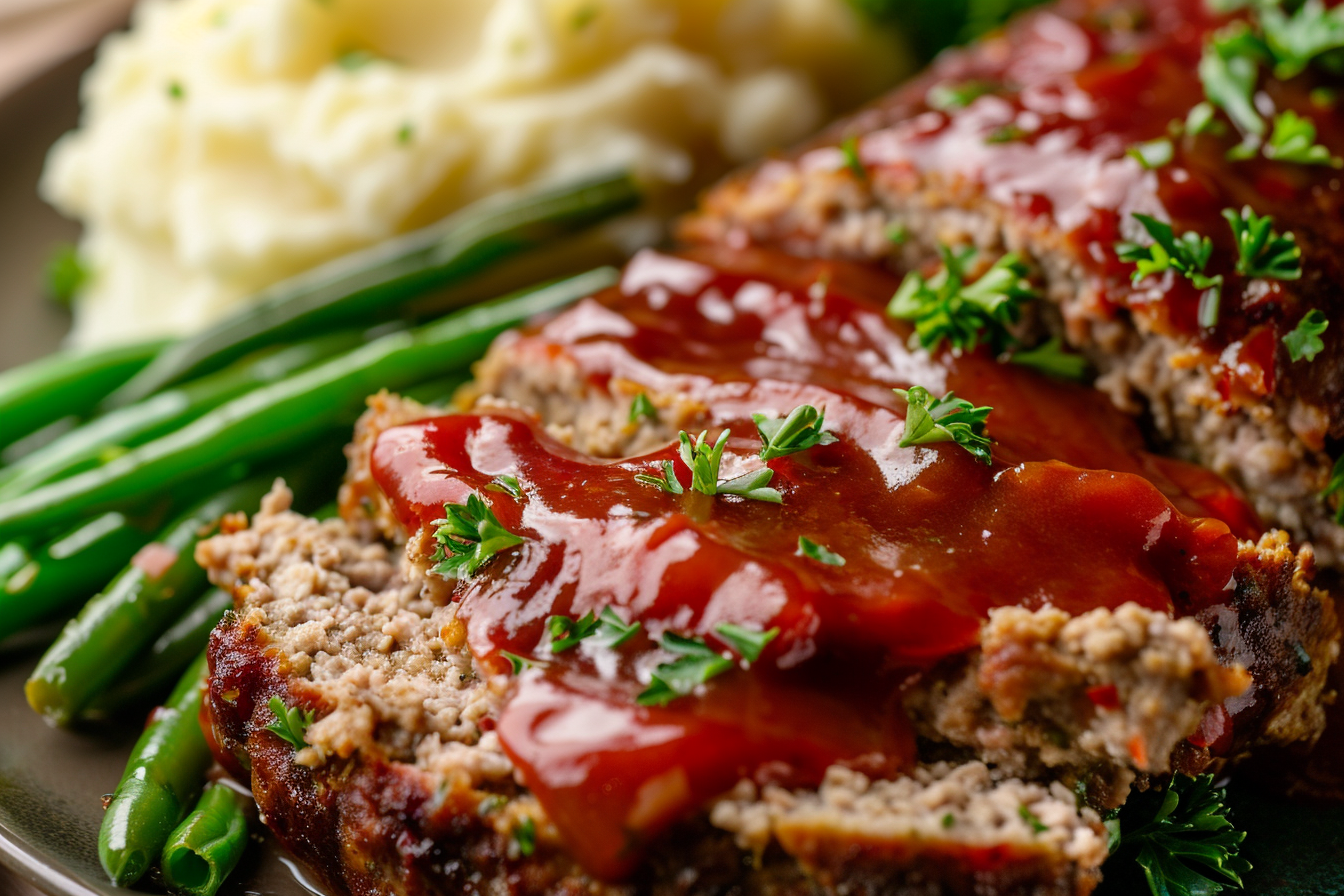Step into a world where comfort food reigns supreme with our extraordinary homemade meatloaf glaze recipe. Imagine a loaf so tender that each slice crumbles under the gentle touch of your fork. Moreover, it is paired with a juicy heart that speaks of meticulous care and perfect seasoning. However, the real enchantment comes from its crown—a lusciously sweet and tangy glaze that not only enhances the flavors within but also adds a stunningly rich, caramelized coating that promises to captivate your taste buds.
This meatloaf glaze recipe is more than just a meal; indeed, it’s a warm hug on a cozy evening. Additionally, it’s best enjoyed alongside a heap of buttery mashed potatoes, each forkful blending effortlessly with the meatloaf’s succulence. Furthermore, complete this delightful culinary experience with a side of crisp, vibrant asparagus, sautéed to perfection, adding just the right touch of freshness to your plate. Consequently, dive into this comforting classic, and let every bite take you home, no matter where you are.
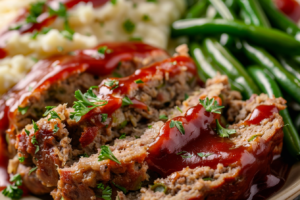
Preparing Your Meatloaf Glaze Recipe: A Step-by-Step Guide
Ingredients:
-
For the Meatloaf your Meatloaf Glaze Recipe :
- 2 pounds ground beef (85% lean)
- 1 cup breadcrumbs
- 1/4 cup milk
- 1 onion, finely chopped
- 2 garlic cloves, minced
- 2 large eggs
- 2 tablespoons Worcestershire sauce
- 1 tablespoon dried parsley
- 1 teaspoon salt
- 1/2 teaspoon ground black pepper
- 1/2 teaspoon dried thyme
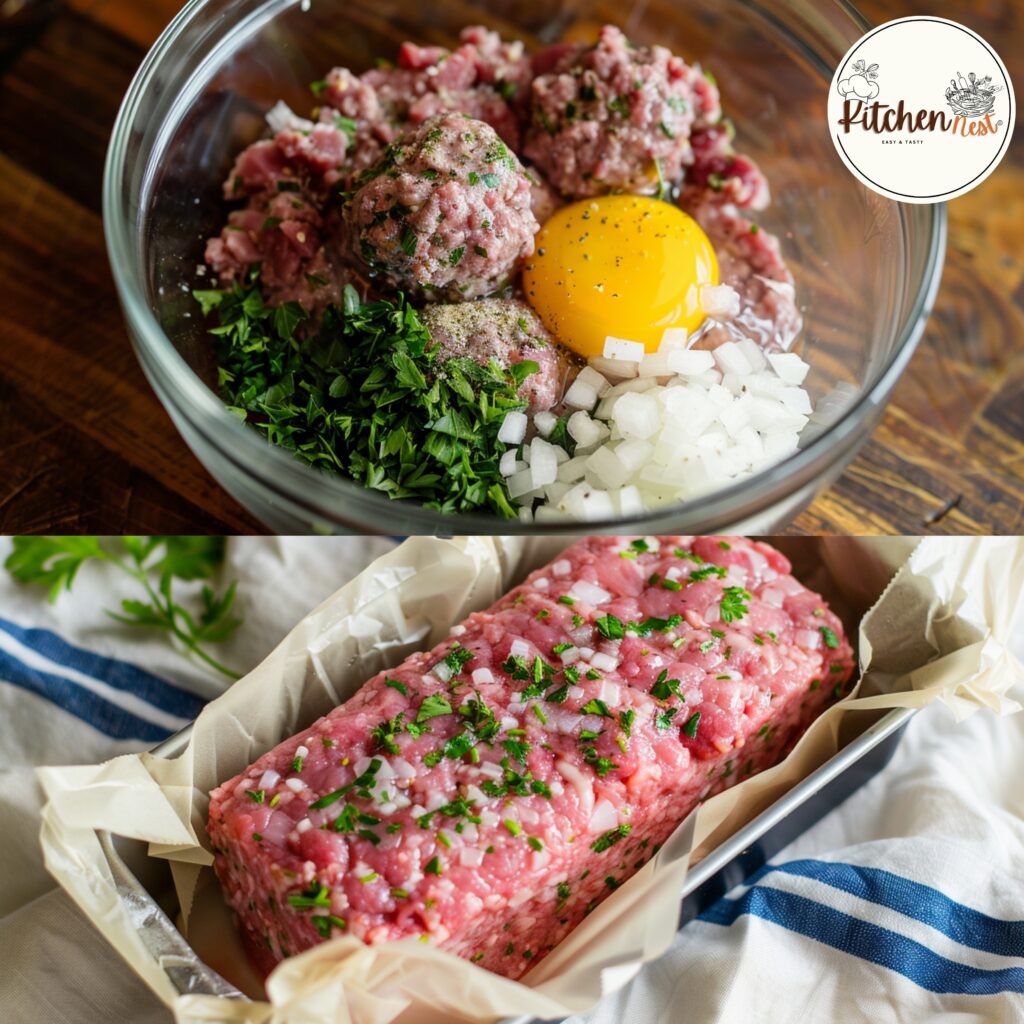
-
For the Glaze:
- 1/2 cup ketchup
- 2 tablespoons brown sugar
- 1 tablespoon apple cider vinegar
- 1 teaspoon mustard
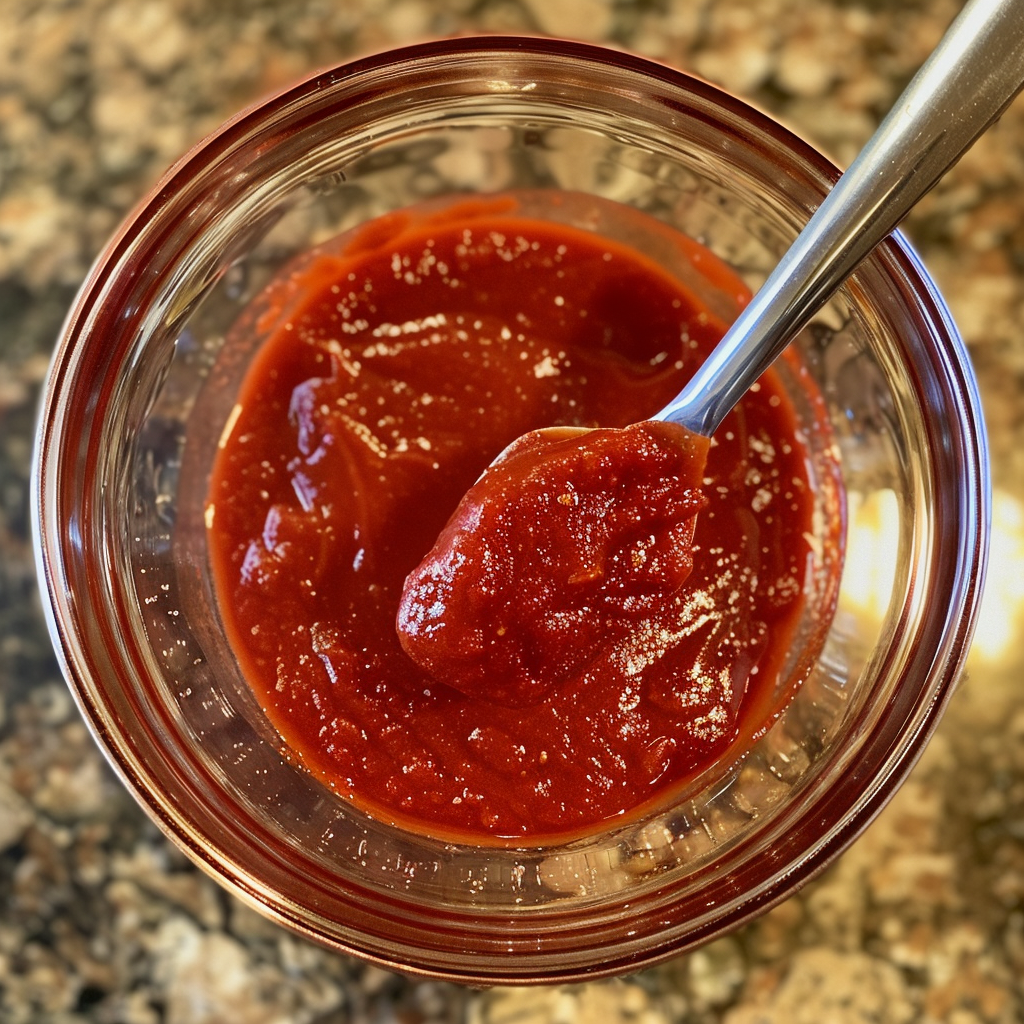
Instructions:
-
Preheat the Oven:
- Set your oven to warm up to 375 degrees Fahrenheit (190 degrees Celsius).
-
Mix the Ingredients:
- In a sizable bowl, mix together the ground beef, breadcrumbs, and milk. Allow the mixture to rest for 5 minutes so the breadcrumbs can soak up the milk.
- Add the chopped onion, minced garlic, eggs, Worcestershire sauce, dried parsley, salt, pepper, and thyme to the beef mixture. Mix everything together until well combined. Avoid overmixing to keep the meatloaf tender.
-
Shape the Meatloaf:
- Transfer the meat mixture to a baking dish. Shape it into a loaf approximately 9 inches long and 5 inches wide.
-
Prepare the Glaze:
- In a small bowl, mix together ketchup, brown sugar, apple cider vinegar, and mustard to create the glaze.
- Spread half of the glaze evenly over the meatloaf before baking. Reserve the other half for later.
-
Bake the Meatloaf:
- Place the meatloaf in the preheated oven and bake for about 55 minutes.
-
Add the Remaining Glaze:
- After the meatloaf has baked for 55 minutes, remove it from the oven and carefully spread the remaining glaze over the top.
- Return the meatloaf to the oven and bake for an additional 15 minutes, or until the internal temperature reaches 160 degrees Fahrenheit (71 degrees Celsius).
-
Rest and Serve:
- Take the meatloaf out of the oven and let it sit for 10 minutes before cutting into slices. This rest period helps the juices redistribute throughout the meatloaf, making it moist and flavorful.
- Slice and serve with sides of mashed potatoes and asparagus.
Tips:
- Enhancing Flavor: For a deeper flavor, you can sauté the onions and garlic before adding them to the meat mixture.
- Checking Doneness: Use a meat thermometer to ensure the meatloaf is cooked through to the correct temperature.
- Serving Suggestion: Pair with creamy mashed potatoes and steamed or roasted asparagus for a classic comfort meal.
This classic homemade meatloaf glaze recipe with its sweet and tangy glaze is not just a dish but a comforting experience, perfect for a hearty family dinner. Enjoy the rich flavors and tender texture as you gather around the table! meatloaf glaze recipe pairs beautifully with many side dishes. For inspiration on what to serve with your glazed meatloaf, check out our easy and delicious Stuffed French Toast Recipe Guide for a sweet contrast or our hearty Ground Beef Enchilada Casserole for a more savory complement.
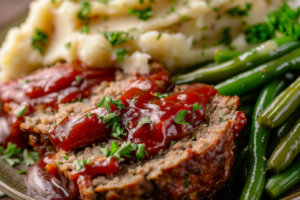
Nutrition Per Serving for Meatloaf with Glaze
- Calories: 344 kcal
- Carbohydrates: 18g
- This includes sugars from the glaze as well as starches from fillers like breadcrumbs or oats.
- Protein: 24g
- Mainly from the ground meat, which is a good source of high-quality protein.
- Fat: 18g
- Includes both saturated and unsaturated fats from the meat and any added oils or eggs.
Additional Nutritional Information:
- Fiber: 2g
- Depending on the use of whole grain binders and the inclusion of vegetables.
- Sugars: 8g
- Largely from the glaze, especially if sweetened with brown sugar or ketchup.
- Cholesterol: 80mg
- Primarily from the meat and eggs used in the recipe.
- Sodium: 500mg
- Can vary significantly based on the ingredients used, such as whether salt or high-sodium sauces like Worcestershire sauce are included.
Vitamins and Minerals:
- Iron: 2mg
- Contributed by the meat, which is a good source of heme iron.
- Zinc: 3mg
- Also from the meat, important for immune function and metabolism.
- Calcium: 40mg
- If milk or cheese is included in the recipe, this would contribute to the calcium content.
- Vitamin B12: 1.2µg
- Found in significant amounts in meat, crucial for nerve health and blood formation.
For an additional resource that provides a hands-on example of a delicious meatloaf glaze recipe, check out this detailed recipe on Here titled “Glazed Meatloaf II”. It offers step-by-step instructions and ingredient lists that can help you perfect your meatloaf glaze technique. Moreover, this guide not only assists in refining your skills but also introduces variations that you might not have considered before. Furthermore, engaging with diverse recipes will expand your culinary repertoire and enhance your overall cooking experience.
Common Mistakes in Crafting Your Meatloaf Glaze Recipe
Balancing Sweetness in Your Meatloaf Sauce
The key to a perfect glaze is the balance of flavors. While many glazes lean towards the sweet side with ingredients like brown sugar or honey, it’s important to balance this with savory and tangy elements. Adding a splash of apple cider vinegar, Worcestershire sauce, or Dijon mustard can offset the sweetness and add a depth of flavor that complements the meatloaf perfectly.
Cook the Glaze Before Applying
To deepen the flavors in your glaze and ensure a smoother application, cook your glaze ingredients together in a small saucepan over medium heat. Let the mixture simmer gently for a few minutes.This process helps marry the flavors and reduces the glaze slightly, thickening it so it adheres better to the meatloaf without running off.
Test the Flavor and Consistency
Before applying the glaze to your meatloaf, always taste it and adjust the seasoning as needed. The glaze should be a harmonious blend of sweet, sour, and savory. Additionally, the consistency is crucial; it should be thick enough to stick to the meatloaf but not so thick that it doesn’t spread evenly. If it’s too runny, continue simmering for a few minutes more to reduce further.
The Best Time to Apply Meatloaf Glaze Recipe
The timing of when you apply the glaze to your meatloaf is critical. Applying it too early can lead to a burnt exterior as the sugars in the glaze can caramelize too quickly. Generally, brushing the glaze on the meatloaf during the last 15-30 minutes of baking provides enough time for the glaze to cook onto the surface without burning, creating a beautifully caramelized topping.
Choosing the Right Ingredients for Meatloaf Topping
The quality of the ingredients in your glaze can significantly affect the taste and quality of your finished dish. Use high-quality ketchup, pure honey, or real maple syrup, and fresh garlic or onions for the best flavor. These ingredients provide a robust base that elevates your glaze beyond the ordinary.
Experiment with Unique Ingredients
FAQs About Meatloaf Glaze recipe
How to Make a Glaze Without Sugar?
Making a meatloaf glaze without sugar is simpler than you might think. You can achieve a deliciously rich glaze by using natural sweeteners or ingredients that offer depth without added sugars. Here are a few options:
- Fruit Purees: Ingredients like unsweetened applesauce or mashed ripe bananas can provide natural sweetness along with a pleasant texture.
- Vegetable Glycerin: This is a sweet, syrup-like liquid derived from plant oils, commonly used as a sugar substitute in cooking.
- Balsamic Reduction: Simmer balsamic vinegar until it thickens and naturally becomes sweeter, then brush it over your meatloaf for a glossy, flavorful coating.
Can I Make Glaze Ahead of Time?
Yes, you can certainly prepare your meatloaf glaze ahead of time. Doing so can enhance the flavors, as the ingredients have more time to meld together. To make your glaze in advance:
- Prepare the glaze as directed by your recipe.
- Let it cool, then store it in an airtight container in the refrigerator.
- Reheat the glaze gently on the stove or in the microwave when you’re ready to use it, adjusting consistency with a little water if necessary.
This approach is especially useful for busy cooks looking to streamline meal preparation.
What Are Some Low-Calorie Glaze Options?
For those watching their calorie intake, there are several ways to create a delicious, low-calorie glaze for meatloaf:
- Tomato Paste and Spices: Combine tomato paste with vinegar, a touch of a sweetener like stevia, and your favorite spices for a robust glaze without all the sugar.
- Mustard and Herb Glaze: Mix Dijon mustard, apple cider vinegar, and a selection of dried or fresh herbs. This glaze adds tons of flavor with very few calories.
- Greek Yogurt and Spices: Blend plain Greek yogurt with spices and a small amount of honey or agave syrup for a creamy, tangy glaze.
Conclusion: Mastering Meatloaf Glaze recipe
Creating the perfect meatloaf glaze is an art that can elevate your home-cooked meatloaf from the everyday to the exceptional. The glaze not only adds a rich, caramelized coating that enhances the aesthetic appeal of the dish but also infuses it with layers of flavor—sweet, tangy, or spicy depending on your preferences. By mastering a few key techniques, such as balancing the sweetness with acidity and savory notes, ensuring the proper application time, and using high-quality ingredients, you can achieve a glaze that complements the meatloaf wonderfully.
Encouraging Home Cooks to Experiment
Moreover, the journey to perfecting your meatloaf glaze doesn’t have to stop with traditional meatloaf glaze recipe. The charm of cooking comes from the ability to experiment and personalize. Whether you’re looking to create a sugar-free glaze, seeking low-calorie options, or wanting to prepare your glaze ahead of time, there are numerous ways to adapt and experiment to suit your dietary needs and flavor preferences.
Experiment with different ingredients like balsamic reduction, fruit purees, or exotic spices to discover unique flavor combinations that could become your new favorite. Each variation not only offers a new taste experience but also adds a personal touch to your cooking, making each meatloaf dish uniquely yours.
As you continue to cook and experiment, remember that each attempt is an opportunity to refine your skills and expand your culinary repertoire. So, don’t be afraid to try new things, tweak traditional recipes, and ask “what if?” in your kitchen adventures. Your perfect meatloaf glaze is just a recipe tweak away!
Whether you’re a seasoned chef or a beginner in the kitchen, embracing the art of making and mastering meatloaf glaze can transform your cooking and delight your dinner guests. So, grab your apron, gather your ingredients, and start glazing your way to meatloaf perfection!

